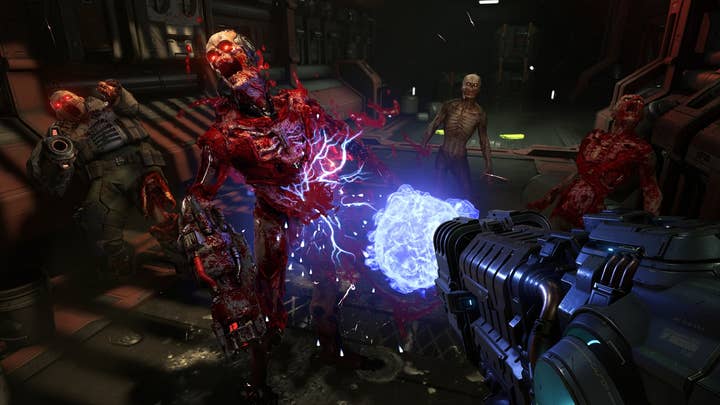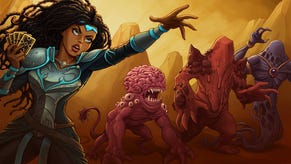Where do you go from Doom?
Doom Eternal's Marty Stratton and Hugo Martin talk about their approach to following up the successful reboot of a seminal classic
When we spoke to Marty Stratton and Hugo Martin two years ago, the game director and creative director (respectively) of the 2016 Doom reboot explained how they used the first two Doom games as a litmus test for development decisions in the reboot.
"If something didn't feel like Doom, we got rid of it and tried something that would feel like Doom," Stratton said at the time.
By many accounts, the developers succeeded at replicating the feel of Doom within a modern AAA shooter. But what does one do for a follow-up? How different is the task of re-imagining a classic from the task of creating a follow-up to a much more recent success? We had a chance to ask Stratton and Martin that at E3 this year as they promoted the upcoming Doom Eternal, and Stratton began by stating the new game is more an evolution than an iteration.

"When we finished Doom 2016, we knew we surprised people and a lot of people just wanted more," Stratton said. "We could have done more, but I think we've looked at Doom Eternal and said, 'How can we raise the bar in every aspect, from technology to design to world-building to the epic scope and scale to the multiplayer battle mode?' We're just pushing every piece of it further than I think we've ever pushed on a game. It's ultimately turning out to be I think the best thing we've ever done."
And if the guiding principle on the last project was to feel like Doom, Martin said the north star on Doom Eternal was "increasing player engagement."
"That was pretty much the primary goal of every decision we've made, how we get people engaged from beginning to end"
Hugo Martin
"That was pretty much the primary goal of every decision we've made, how we get people engaged from beginning to end," Martin said. "Not even just the beginning of the level to the end of the level or the combat, but the entire game -- that the third act of the single-player campaign is just as compelling if not more so than the first act was. It was challenging because people loved the last game so much, and we really couldn't use the same exact tricks as last time to engage the player because it's like old hat to them at this point.
"We wanted to make sure the level design and the combat really gave you something to have to master. You master and conquer the levels just as much as you conquer the combat and encounters, and that's what feels really empowering to the player, something that is earned. It's very easy for us to make it, 'Here's a super powerful gun and some hallways; just walk down them and slaughter everything.' That's not a $60 game in my opinion. So I think engagement was our overriding theme for this game."
Echoing our last conversation, the pair of developers pointed to multiplayer as a missed opportunity. It lacked pacing, they said, and dramatic moments. The answer they came up with was Doom Eternal's Battle Mode, in which one player takes the role of a fully equipped Slayer character (the protagonist of the single-player game), and two other players pick from an assortment of demons with different movement and combat abilities.
"So if we come up on each other [in a Doom 2016 multiplayer match] and all the game is relying on from a design perspective is aiming and shooting, well there are going to be people who aim and shoot better than you and there's pretty much nothing you can do about that," Martin explained. "That made death a frustrating experience because it meant you were just better than me. In this game, I can overcome your incredible twitch skills with teamwork and strategy, which gives me a chance. Then it allows the game to have what 2016 had none of: metas. There's some real depth to this experience."
"One of our mantras is lead, don't follow. And at a high level, with the multiplayer of 2016, it felt like we followed."
Marty Stratton
"One of our mantras is lead, don't follow," Stratton said. "And at a high level, with the multiplayer of 2016, it felt like we followed; like we picked and chose from a bunch of different games to make something that was a fun multiplayer experience, but not the Doom multiplayer experience people wanted. We didn't really take from the Doom campaign people loved. There was no Slayer present in that Doom multiplayer. So really the genesis of Battle Mode is taking the Doom combat, that Slayer vs. Demon combat people know and love from the campaign, and making it a social experience, something you can do with your friends."
While asynchronous multiplayer has been done before, Martin said it was less a case of the team following instead of leading, and more a natural response to their dissatisfaction with the previous game's multiplayer.
Martin added: "In [the 2016 game's] multiplayer, there were probably more things we did wrong than right. Playing as a demon was one of the right things; that felt pretty good, so we knew there was a spark there. And you follow the sparks."
Martin also noted that Doom Eternal's multiplayer mode was developed internally (id worked with Certain Affinity for the multiplayer of the 2016 game), which allowed the developers to "pivot into the sparks" much faster.

We followed up on another point from our previous interview, the idea that Doom's over-the-top violence makes it more acceptable for audiences. But this time the question was more about making it acceptable for developers. Pointing out a Kotaku report on a Mortal Kombat artist who developed post-traumatic stress disorder from immersing themselves in reference material for the game, we asked if Stratton and Martin had seen any similar issues with their own staff.
"Our gore is not real," Martin replied. "It's more Warner Bros. animation level of gore. It's zany Tex Avery stuff more than it is shish kebabing somebody's eyeball on the end of a stake... And we've always ridden that line. It's ridiculous. It's cartoonish gore and violence, so I think that makes it less disturbing to play and to create for the artist."
Stratton suggested that if any artists did develop such problems, they would be happy to have work on cinematics, gun animations, or other such content. Both developers noted also that Doom's enemies are not humans.
"That's a real conscious decision on our part too," Martin said. "I have kids. There's no nudity. There's no cursing in our game. You don't kill human beings; you actually protect them. It's a violent game, there's no question. But there's a nuance to it, and I think we've never had any issues internally with any of the artists. And I don't see us having one in the future, just because the style of the content is, while still being gory, not quite as real."









